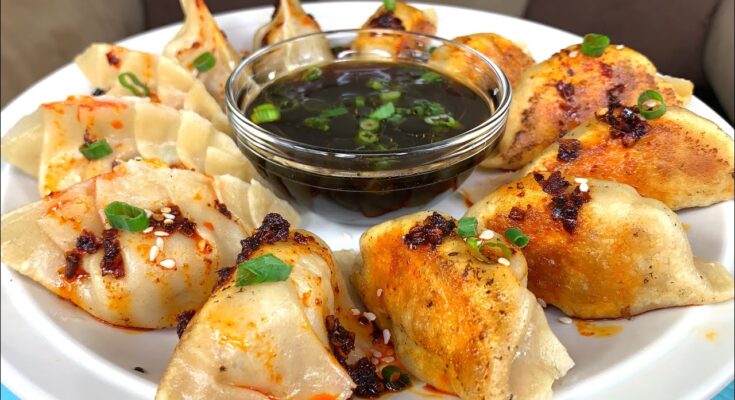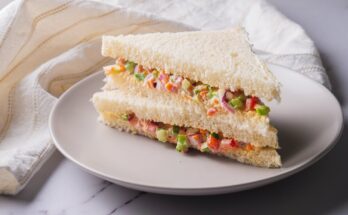Pork Dumpling Recipe: Pork dumplings are more than just a tasty treat—they’re a cultural icon deeply rooted in Chinese cuisine and embraced around the world. From family gatherings to festive celebrations, dumplings symbolize unity and prosperity. When you bite into a well-made pork dumpling, you’re tasting centuries of tradition. The beauty of dumplings lies in their versatility: they can be steamed, boiled, or pan-fried, and each method unlocks a unique texture and flavor.
Think of them as the ultimate comfort food wrapped in a tiny, chewy package. Whether you’re a home cook or a culinary novice, mastering pork dumplings is an achievement that pays off with every delicious bite. What’s more, they make a fantastic project for weekends or dinner parties. You can make a big batch and freeze them for later. It’s food prep at its most delicious!
Why Pork Dumplings Are So Popular
Why do pork dumplings reign supreme? Simply put, the combination of juicy pork, savory seasonings, and a soft or crispy wrapper is irresistible. Pork is tender and flavorful, making it a perfect base for the filling. Add in ingredients like garlic, ginger, soy sauce, sesame oil, and scallions, and you’ve got a flavor bomb in every bite.
They’re also easy to adapt. You can tweak the filling with mushrooms, cabbage, or chives—or even mix in other meats like shrimp or chicken. Plus, pork dumplings fit any occasion. They’re a hearty appetizer, a main course, or a quick snack. Whether you’re dipping them in soy sauce or spicy chili oil, there’s no wrong way to enjoy them.
Essential Ingredients for Pork Dumplings
Meat and Filling Ingredients
The heart of any dumpling is its filling. For pork dumplings, ground pork with a good ratio of fat (around 20%) is ideal. This ensures juiciness and flavor without being greasy. Here’s what you’ll typically need for about 30-40 dumplings:
- Ground pork – 1 lb (450g)
- Finely chopped napa cabbage – 1 cup (helps with texture and moisture)
- Green onions (scallions) – 4-5 stalks, minced
- Minced garlic – 2-3 cloves
- Fresh ginger – 1 tbsp, grated
- Soy sauce – 2 tbsp
- Sesame oil – 1 tbsp
- Salt and pepper – to taste
- Optional: Shaoxing wine or rice vinegar for a touch of acidity
The cabbage is usually salted and squeezed to remove excess water—this keeps the dumpling from becoming soggy. You can also toss in chopped mushrooms, leeks, or even tofu for variety. The key is balancing texture, moisture, and flavor.
Dumpling Wrappers: Store-Bought vs. Homemade
When it comes to wrappers, you’ve got two solid options: store-bought or homemade. Most grocery stores carry round dumpling wrappers in the refrigerated section, usually labeled as “gyoza wrappers” or “dumpling skins.” These are convenient and work just fine for most purposes.
But if you’ve got the time and the inclination, making them from scratch offers a more satisfying bite and chewy texture. Homemade wrappers use just two ingredients: flour and water. You knead them into a dough, roll them out, and cut them into circles. It’s a bit of work, but the results are worth it.
Seasonings and Sauces
Seasonings elevate your filling, but the dipping sauce is where things really shine. Here are a few must-haves:
- Soy sauce – base of most dipping sauces
- Rice vinegar – for tanginess
- Chili oil – for a spicy kick
- Minced garlic – boosts flavor
- Sesame seeds – adds nuttiness
- Sugar – a pinch balances the salt and acid
Mix and match these ingredients to create your perfect dipping sauce. One popular combo: 2 parts soy sauce, 1 part vinegar, a dash of chili oil, and a sprinkle of sesame seeds.
Tools and Equipment You’ll Need
Kitchen Basics for Dumpling Making
Making dumplings doesn’t require a commercial kitchen. Here’s what you’ll need:
- Mixing bowl – for combining the filling
- Cutting board and knife – to chop your veggies
- Spoons or small scoop – for portioning the filling
- Dumpling wrappers – store-bought or homemade
- Small bowl of water – to seal the wrappers
- Nonstick pan or wok – for pan-frying
- Steamer basket or large pot – for steaming or boiling
A clean workspace is key—dumplings can get sticky fast. Lay out parchment paper or a lightly floured tray to place your finished dumplings.
Optional Tools for Faster Preparation
If you’re making dumplings in bulk, some tools can speed things up:
- Dumpling press or mold – helps with uniform folds
- Food processor – for faster chopping
- Rolling pin – if making homemade wrappers
- Steamer liner or cabbage leaves – prevents sticking during steaming
While not necessary, these tools can make the dumpling-making experience smoother and more enjoyable.
Step-by-Step Dumpling Preparation Guide
Step 1: Preparing the Filling
Start by preparing your ingredients. Finely chop the napa cabbage, sprinkle with a bit of salt, and let it sit for 10 minutes. Then squeeze out the water using a clean towel or cheesecloth. This step is crucial to prevent soggy dumplings.
In a large bowl, mix the ground pork, cabbage, scallions, garlic, ginger, soy sauce, sesame oil, and any optional ingredients you like. Use your hands or a spoon to combine everything thoroughly, but don’t overmix or the filling can become tough. You want it cohesive but still a bit loose.
Taste test a bit of filling by microwaving a small spoonful for 15-20 seconds—this lets you adjust the seasoning before you start wrapping.
Step 2: Prepping the Wrappers
Now that your filling is ready, it’s time to get your dumpling wrappers prepped and set up a little dumpling station. If you’re using store-bought wrappers, take them out of the package and keep them under a slightly damp towel—this prevents them from drying out while you work. Dry wrappers crack and make folding a nightmare, so keeping them moist is key.
If you made your wrappers from scratch, be sure they’re rolled thin but not so thin that they tear during folding or cooking. A 3-inch diameter is usually perfect. Dust each wrapper lightly with flour to avoid sticking.
Prepare a small bowl of water to seal your dumplings. This acts like edible glue when you’re closing the edges. Also, set aside a floured tray or parchment paper for your finished dumplings so they don’t stick together.
This step might seem minor, but it’s the setup that ensures a smooth, mess-free folding process. Trust me, a well-prepped station turns dumpling-making from chaos to zen.
Step 3: Filling and Folding the Dumplings
Now comes the fun part—folding! Place one wrapper in your palm and spoon about one teaspoon of filling into the center. Don’t overfill, or you’ll struggle to seal them. Dip your finger in the water and moisten the edge of the wrapper.
Fold the wrapper in half over the filling to form a half-moon shape. Press the center of the edges together first, then pleat one side as you press to seal. You can make 3-4 pleats on one side or both for a classic look. The goal is to seal them well without tearing the wrapper.
There are several folding techniques:
- Simple fold – just press the edges together, good for beginners.
- One-sided pleat – pleat only one side while the other stays flat.
- Double-sided pleat – pleat both sides toward the center for a fancy look.
Each dumpling should be uniform in size to ensure even cooking. Don’t be afraid to practice a few—you’ll get the hang of it fast. Line up your dumplings on the tray as you go, making sure they don’t touch.
Step 4: Cooking Techniques – Boiling, Steaming, Pan-Frying
There’s no “best” way to cook dumplings—it really depends on your mood and what texture you’re craving. Here are the three main cooking methods:
Boiling
Bring a large pot of water to a gentle boil. Drop in 8–10 dumplings at a time. Stir immediately to keep them from sticking to the bottom. When they float to the top, let them cook for another 2-3 minutes. Remove with a slotted spoon.
Boiled dumplings are soft and chewy—perfect for a simple soy dipping sauce.
Steaming
Place dumplings in a steamer lined with parchment paper or cabbage leaves. Make sure they don’t touch. Steam over boiling water for 8–10 minutes. This method gives a tender, slightly glossy finish.
Great for when you want something a bit lighter but still juicy.
Pan-Frying (Potstickers)
Heat 1 tbsp of oil in a non-stick skillet over medium heat. Arrange dumplings flat-side down. Let them fry for 2–3 minutes until the bottoms are golden brown. Then, add about 1/4 cup of water and cover immediately. Steam for 5–6 minutes. Remove the lid and cook for another minute until the water evaporates.
Crispy, golden, and juicy—these are a crowd favorite and Instagram-worthy too.
Tips for Perfect Pork Dumplings
Perfecting dumplings takes practice, but these tips can make a big difference from day one:
- Balance the flavors – Don’t be shy with seasoning. A bland filling ruins the magic.
- Avoid sogginess – Always drain veggies like cabbage, mushrooms, or zucchini.
- Seal tightly – Press out any air bubbles when folding. Loose edges = broken dumplings.
- Cook in batches – Don’t overcrowd your pot or pan, or they’ll stick and tear.
- Use a non-stick pan – Especially for frying, this prevents disasters.
Want to freeze your dumplings? Line a tray with parchment, place the uncooked dumplings so they’re not touching, and freeze until solid. Then transfer to a freezer bag. No need to thaw—just cook straight from frozen, adding an extra 1–2 minutes.
Experiment with fillings, sauces, and cooking styles until you find your dumpling sweet spot.
Common Mistakes to Avoid
Filling Too Much or Too Little
It’s tempting to overload your dumpling with filling—after all, more is better, right? Not in this case. Overstuffed dumplings are much harder to seal properly and are more likely to burst open while cooking. On the flip side, under-filled dumplings end up doughy and disappointing. Aim for about one teaspoon of filling per wrapper. It might not seem like much, but it balances perfectly with the wrapper’s thickness for that ideal bite.
Skipping the Moisture Control
Watery filling is a dumpling killer. Vegetables like cabbage, zucchini, or mushrooms release a lot of moisture. Always salt and squeeze the water out before mixing them into your filling. Otherwise, your dumplings may end up soggy and leak during cooking. Moist filling is good—wet and dripping is not.
Improper Sealing and Folding
If you don’t seal your dumplings well, all that delicious filling can escape during cooking. Always use water to moisten the edges of the wrappers and press firmly. Take the time to practice your folds—even a simple half-moon fold, if sealed tightly, will do the job. Pleating adds flair, but sealing is what matters most.
Serving Suggestions and Variations
Creative Fillings and Flavors
Pork dumplings are a classic, but once you’ve got the basics down, why not experiment?
- Pork and shrimp – A surf-and-turf twist.
- Pork and chive – A Chinese takeout favorite.
- Spicy pork – Add chili flakes or kimchi to the filling.
- Pork and mushroom – Earthy and rich.
You can also switch the protein entirely—try chicken, beef, tofu, or plant-based meat alternatives for a different spin.
How to Serve Them
Serve dumplings with a dipping sauce trio: one soy-based, one spicy, and one with vinegar. Garnish with sesame seeds, green onions, or chili flakes for color and kick.
Pair them with:
- Stir-fried vegetables
- Fried rice or lo mein
- Hot and sour soup or miso broth
They also make an excellent party dish—serve on a platter with toothpicks for an easy-to-eat snack.
How to Store and Reheat Dumplings
Storing Leftovers
Cooked dumplings can be stored in an airtight container in the fridge for up to 3 days. Let them cool before refrigerating to avoid sogginess.
Uncooked dumplings can be frozen as mentioned earlier. Lay them flat on a tray until firm, then transfer to a zip-top bag. They’ll keep for up to 3 months.
Reheating Options
- Steam – Place over boiling water for 5–6 minutes.
- Microwave – Place on a plate with a damp paper towel over the top; microwave for 1-2 minutes.
- Pan-fry – Reheat with a touch of oil for that crispy bottom again.
Avoid boiling already cooked dumplings—they’ll fall apart. Always reheat gently to maintain the wrapper’s integrity.
Healthier Pork Dumpling Alternatives
Low-Calorie Swaps
You can make your dumplings healthier without sacrificing flavor:
- Lean pork – Use 90% lean pork or mix with ground turkey.
- Whole wheat wrappers – Adds fiber and nutrition.
- Add more veggies – Bulk up the filling with mushrooms, carrots, or spinach.
Skip frying and opt for steaming or boiling instead. Use low-sodium soy sauce and skip sugar in the dipping sauces.
Gluten-Free or Keto Options
- Gluten-free wrappers – Available in specialty stores or make your own with rice flour.
- Lettuce wraps – For a keto-friendly, carb-free alternative.
- Coconut aminos – A soy-free, low-sodium sauce substitute.
These variations still give you all the flavor without compromising your dietary goals.
FAQs about Pork Dumpling Recipe
Q1: Can I make dumpling filling ahead of time?
Yes! You can make the filling a day in advance. Just store it in an airtight container in the fridge until you’re ready to wrap.
Q2: Why are my dumplings falling apart while cooking?
This usually means they weren’t sealed tightly or the wrappers were too thin. Be sure to press the edges well and avoid overstuffing.
Q3: What can I use if I can’t find dumpling wrappers?
Wonton wrappers or even rolled-out biscuit dough can be used in a pinch. Just adjust the size and cooking time accordingly.
Q4: Can I bake dumplings instead of frying or steaming?
Baking is possible but not traditional. It works best with a light brushing of oil and high heat (around 400°F or 200°C) for 15-20 minutes.
Q5: How do I know when dumplings are fully cooked?
The wrapper becomes translucent and slightly firm, and the internal temperature of the pork filling should be at least 160°F (71°C).
Conclusion
There you have it—a complete, step-by-step guide to making incredible pork dumplings from scratch. From the filling to the folding and cooking to serving, each step brings you closer to dumpling perfection. Whether you’re making them for Lunar New Year, a cozy night in, or a weekend cooking project, pork dumplings never disappoint.
The beauty of dumplings is that they’re endlessly adaptable. Want them spicy? Go for it. Want to load them with veggies? Absolutely. The only rule is to have fun and enjoy the process. And once you’ve mastered the basics, you’ll find yourself craving—and creating—these juicy little pockets of goodness again and again.



